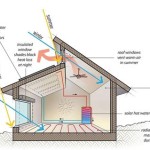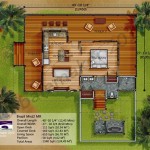An architecture house plan, or home plan, is a type of technical drawing that provides a detailed blueprint for the construction of a house. It typically includes a scaled floor plan, elevations, and various other details such as cross sections, roof plans, and site plans. Architecture house plans serve as a guide for builders and contractors to follow when constructing a home, ensuring that it is built according to the architect’s specifications.
They are essential for ensuring that the house is structurally sound, meets building codes, and is aesthetically pleasing. For example, an architecture house plan for a three-bedroom, two-bathroom home might include a detailed plan of the first and second floors, showing the location of rooms, windows, and doors. It would also include elevations of the front, back, and sides of the house, as well as a roof plan showing the pitch and type of roofing material to be used.
In the following sections, we will delve deeper into the key elements of architecture house plans, explore their significance, and discuss factors to consider when choosing a house plan that suits your needs.
Architecture house plans are crucial for constructing a home that meets your specific needs and preferences. Here are 8 important points to consider when working with architecture house plans:
- Floor Plans: Outline the layout of each level of the house.
- Elevations: Show the exterior appearance of the house from different sides.
- Sections: Provide vertical cut-away views of the house.
- Roof Plans: Indicate the type and pitch of the roof.
- Site Plans: Depict the house’s placement on the land.
- Foundation Plans: Specify the type and dimensions of the foundation.
- Material Lists: Enumerate the materials required for construction.
- Building Codes: Ensure compliance with local building regulations.
By carefully considering these elements, you can create a comprehensive architecture house plan that will guide the construction of your dream home.
Floor Plans: Outline the layout of each level of the house.
Floor plans are detailed drawings that depict the layout of each level of a house. They show the arrangement of rooms, windows, doors, and other features, providing a comprehensive overview of the house’s interior. Floor plans are essential for visualizing the flow and functionality of a home, as well as for ensuring that it meets building codes and regulations.
A typical floor plan includes the following elements:
- Walls: Indicated by solid lines, walls define the boundaries of rooms and other spaces.
- Doors: Represented by arcs or rectangles, doors indicate the location of entryways and passageways.
- Windows: Shown as squares or rectangles, windows represent the placement of natural light sources.
- Dimensions: Floor plans typically include measurements to indicate the size and proportions of rooms and other features.
Floor plans can vary in complexity depending on the size and complexity of the house. Simple floor plans may only show the basic layout of a house, while more detailed floor plans may include additional information such as furniture placement, electrical outlets, and plumbing fixtures.
Floor plans are essential tools for architects, builders, and homeowners. They are used to:
- Plan the layout of a house before construction begins.
- Obtain building permits from local authorities.
- Communicate design ideas between architects and builders.
- Visualize the flow and functionality of a home.
- Make changes to a house’s design before construction begins.
Elevations: Show the exterior appearance of the house from different sides.
Elevations are drawings that show the exterior appearance of a house from different sides. They are typically drawn to scale and include details such as the height and width of the house, the location of windows and doors, and the type of roofing material used.
Elevations are important for visualizing the exterior of a house and for ensuring that it is aesthetically pleasing. They are also used by builders to construct the house according to the architect’s specifications.
There are four main types of elevations:
- Front elevation: Shows the front of the house.
- Rear elevation: Shows the back of the house.
- Left elevation: Shows the left side of the house.
- Right elevation: Shows the right side of the house.
In addition to the four main elevations, there may also be additional elevations for complex houses, such as side elevations or roof elevations.
Elevations are an essential part of architecture house plans. They provide a comprehensive view of the exterior of the house and are used by architects, builders, and homeowners to visualize and construct the house.
Sections: Provide vertical cut-away views of the house.
Sections are vertical cut-away drawings that show the interior construction of a house. They are typically drawn to scale and include details such as the height and width of the house, the thickness of the walls, and the location of the framing members. Sections are important for visualizing the interior of a house and for ensuring that it is structurally sound.
Sections can be used to show the following:
- The layout of the house’s interior.
- The location of the framing members.
- The thickness of the walls.
- The height of the ceilings.
- The location of the plumbing, electrical, and HVAC systems.
Sections are an essential part of architecture house plans. They provide a detailed view of the interior of the house and are used by architects, builders, and homeowners to visualize and construct the house.
Here are some examples of how sections are used in architecture house plans:
- To show the layout of a house’s interior, a section can be drawn through the center of the house from front to back. This type of section is called a longitudinal section.
- To show the location of the framing members, a section can be drawn through the house from side to side. This type of section is called a transverse section.
- To show the thickness of the walls, a section can be drawn through the wall at a specific point. This type of section is called a detail section.
Sections are an important tool for architects, builders, and homeowners. They provide a detailed view of the interior of the house and are used to visualize and construct the house.
Roof Plans: Indicate the type and pitch of the roof.
Purpose of Roof Plans
Roof plans are detailed drawings that show the type and pitch of the roof. They are typically drawn to scale and include details such as the dimensions of the roof, the location of the roof trusses, and the type of roofing material to be used. Roof plans are important for visualizing the roof of a house and for ensuring that it is structurally sound and weatherproof.
Components of Roof Plans
Roof plans typically include the following components:
- Dimensions: The dimensions of the roof are indicated on the roof plan, including the length, width, and height of the roof.
- Roof trusses: The location of the roof trusses is shown on the roof plan. Roof trusses are the structural members that support the roof.
- Roofing material: The type of roofing material to be used is indicated on the roof plan. Common roofing materials include asphalt shingles, metal roofing, and tile roofing.
Importance of Roof Plans
Roof plans are an important part of architecture house plans. They provide a detailed view of the roof of the house and are used by architects, builders, and homeowners to visualize and construct the house.
Roof plans are also important for obtaining building permits from local authorities. Building permits are required to ensure that the house is built according to the building code. The building code is a set of regulations that govern the construction of buildings.
Paragraph after details
Roof plans are an essential part of architecture house plans. They provide a detailed view of the roof of the house and are used by architects, builders, and homeowners to visualize and construct the house. Roof plans are also important for obtaining building permits from local authorities.
Site Plans: Depict the house’s placement on the land.
Site plans are detailed drawings that show the house’s placement on the land. They typically include the following information:
- Property lines: The property lines indicate the boundaries of the land on which the house will be built.
- Setbacks: Setbacks are the minimum distances that the house must be set back from the property lines. Setbacks are required by local building codes to ensure that there is adequate space between houses and to protect the safety of the public.
- Driveway and walkways: The driveway and walkways show how vehicles and pedestrians will access the house. Driveways and walkways must be designed to meet local building codes and to provide safe access to the house.
- Landscaping: The landscaping plan shows the location of trees, shrubs, and other landscaping features on the property. Landscaping can be used to improve the appearance of the property and to provide privacy.
Site plans are an important part of architecture house plans. They provide a detailed view of the house’s placement on the land and are used by architects, builders, and homeowners to visualize and construct the house. Site plans are also important for obtaining building permits from local authorities.
Foundation Plans: Specify the type and dimensions of the foundation.
Foundation plans are detailed drawings that specify the type and dimensions of the foundation for a house. They typically include the following information:
- Type of foundation: The type of foundation is indicated on the foundation plan. Common types of foundations include slab foundations, crawl space foundations, and basement foundations.
- Dimensions of the foundation: The dimensions of the foundation are indicated on the foundation plan. The dimensions include the length, width, and depth of the foundation.
- Reinforcement: The reinforcement for the foundation is indicated on the foundation plan. Reinforcement is used to strengthen the foundation and to prevent it from cracking.
- Footings: The footings for the foundation are indicated on the foundation plan. Footings are used to spread the load of the house over a larger area of soil.
Foundation plans are an important part of architecture house plans. They provide a detailed view of the foundation of the house and are used by architects, builders, and homeowners to visualize and construct the house. Foundation plans are also important for obtaining building permits from local authorities.
Material Lists: Enumerate the materials required for construction.
Purpose of Material Lists
Material lists are detailed lists of all the materials required to construct a house. They typically include the following information:
- Type of material: The type of material is indicated on the material list. Common types of materials used in house construction include lumber, concrete, brick, and steel.
- Quantity of material: The quantity of material is indicated on the material list. The quantity is typically expressed in units such as feet, yards, or pounds.
- Size of material: The size of the material is indicated on the material list. The size is typically expressed in units such as inches, feet, or yards.
- Supplier of material: The supplier of the material is indicated on the material list. The supplier is typically a company that sells building materials.
Importance of Material Lists
Material lists are an important part of architecture house plans. They provide a detailed list of all the materials required to construct a house and are used by architects, builders, and homeowners to visualize and construct the house. Material lists are also important for obtaining building permits from local authorities.
Benefits of Material Lists
Material lists offer several benefits, including:
- Accurate cost estimation: Material lists help contractors to accurately estimate the cost of constructing a house. By knowing the quantity and type of materials required, contractors can get accurate quotes from suppliers.
- Reduced waste: Material lists help to reduce waste by ensuring that the correct quantity of materials is ordered. This can save money and help to protect the environment.
- Improved communication: Material lists improve communication between architects, builders, and homeowners. By having a detailed list of the materials required, everyone involved in the construction process can be on the same page.
Paragraph after details
Material lists are an essential part of architecture house plans. They provide a detailed list of all the materials required to construct a house and are used by architects, builders, and homeowners to visualize and construct the house. Material lists are also important for obtaining building permits from local authorities and offer several benefits, including accurate cost estimation, reduced waste, and improved communication.
Building Codes: Ensure compliance with local building regulations.
Building codes are sets of rules and regulations that govern the construction of buildings. They are in place to ensure that buildings are safe, structurally sound, and energy-efficient. Building codes are typically developed by local governments and may vary from one jurisdiction to another.
- Protect public safety: Building codes are in place to protect the safety of the public. They ensure that buildings are constructed in a way that minimizes the risk of collapse, fire, and other hazards.
- Ensure structural integrity: Building codes ensure that buildings are structurally sound and able to withstand the forces of nature, such as earthquakes and hurricanes. They also ensure that buildings are properly ventilated and have adequate fire protection.
- Promote energy efficiency: Building codes promote energy efficiency by requiring the use of energy-efficient materials and appliances. This helps to reduce the environmental impact of buildings and lower energy costs for homeowners.
- Facilitate accessibility: Building codes require that buildings be accessible to people with disabilities. This includes providing ramps, elevators, and other features that make it easier for people with disabilities to enter and navigate buildings.
Building codes are an important part of architecture house plans. They ensure that houses are safe, structurally sound, energy-efficient, and accessible. By complying with building codes, architects and builders can help to create safe and comfortable homes for their clients.










Related Posts








